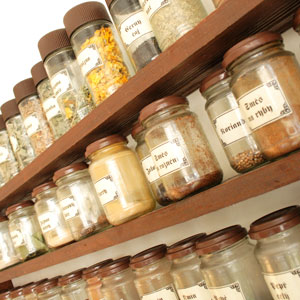Your Spices Could Contain Insect Parts and Rat Hairs!
By Chris Williams on November 18, 2013.
 Most of the cooking spices that we buy in the U.S. are imported, and those spices are often contaminated, according to the Food and Drug Administration.
Most of the cooking spices that we buy in the U.S. are imported, and those spices are often contaminated, according to the Food and Drug Administration.
In an October 30 report, FDA reports its finding that 12% of imported spices are adulterated by filth. That means that there’s a fair chance that the spices that you’ve just measured into your homemade vegetable soup contain filth like bits of animal poop, insect parts, hairs from rats and people, disease-causing bacteria like salmonella, and other contaminants. “Other contaminants” includes stones, twigs, staples, wood slivers, plastic, synthetic fibers, and rubber bands!
Just about the only spice used in the U.S. that is not imported is dehydrated onion. Don’t ask me why. The spices come from all over: Brazil, China, Mexico, India, Malaysia, South America, Turkey, and Vietnam. Imported spices seem to be contaminated at about double the rate of other imported foods.
The most common contaminants found in imported spices were live insects and dead insects (either whole or in parts), and animal hair. Animal hair in most cases means the hair of rats or mice. And when there’s contamination with rodent hair, there is usually also contamination with rodent feces, according to the FDA. [Here’s a fun fact: If the rodent hair doesn’t have a root attached, that means it came from rodent feces.]
How can FDA allow this filth in our food?
It’s all perfectly legal, up to a point. FDA sets “Food Defect Action Levels” for specific foods on the premise that these levels pose no inherent health hazard to people. As long as the amount of contamination is below the Action Level, the food is deemed safe to eat. For example, according to FDA, 100 grams of cornmeal (about the amount you use in your favorite cornbread recipe) can safely contain 2 whole insects, 100 insect parts, and either 4 rodent hairs or 2 chunks of rodent poop, your choice!
Sickness from Salmonella Contamination is a Real Concern
Of greater concern are disease pathogens that can sicken people. Although several types of microbes were found, salmonella was found in almost 7% of the imported spices tested. When swallowed, salmonella can cause symptoms within 12-72 hours. The resulting diarrhea, fever, and abdominal cramps last up to a week.
Since 1973, there have been 14 U.S. illness outbreaks linked to spices, resulting in 1,900 illnesses and two deaths. Ten of the 14 outbreaks were linked to salmonella bacteria and most involved black pepper. Other spices found to contain salmonella were red pepper, white pepper, curry, fennel seed, turmeric and some seasoning mixes.
While black pepper was most often implicated in salmonella outbreaks, FDA actually found the highest levels of salmonella in leaf-based seasonings like basil and oregano. Mexico was identified as the country exporting the highest number of salmonella-contaminated spices (14%), followed by India (9%). Canada’s spices had the lowest level of salmonella, at less than 1%.
The fact that more people haven’t gotten sick, given the levels of salmonella contamination, may be due to the fact that people use only a very small amount of spices on their food, or that the spices are cooked, or that the industry’s safety measures are proving effective. However, FDA reports that the level of contamination in imported spices is about the same as it was during similar testing 30 years ago.